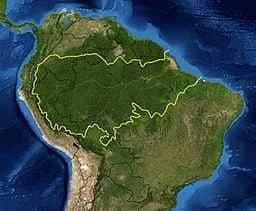AMAZON
Amazon rainforest
"Amazonia" redirects here. For other uses, see Amazonia (disambiguation).
The Amazon rainforest (Portuguese: Floresta Amazônica or Amazônia; Spanish: Selva Amazónica, Amazonía or usually Amazonia; French: Forêt amazonienne; Dutch: Amazoneregenwoud), also known in English as Amazonia or the Amazon Jungle, is a moist broadleaf forest in the Amazon biome that covers most of the Amazon basin of South America. This basin encompasses 7,000,000 km2 (2,700,000 sq mi), of which 5,500,000 km2 (2,100,000 sq mi) are covered by the rainforest. This region includes territory belonging to nine nations. The majority of the forest is contained within Brazil, with 60% of the rainforest, followed by Peru with 13%, Colombia with 10%, and with minor amounts in Venezuela, Ecuador, Bolivia, Guyana, Suriname and French Guiana. States or departments in four nations contain "Amazonas" in their names. The Amazon represents over half of the planet's remaining rainforests,[1] and comprises the largest and most biodiverse tract of tropical rainforest in the world, with an estimated 390 billion individual trees divided into 16,000 species.[2]
Amazon rainforest
Forest
Amazon Manaus forest.jpg
Amazon rainforest, near Manaus, Brazil.
Countries
Brazil, Peru, Colombia, Venezuela, Ecuador, Bolivia, Guyana, Suriname, France (French Guiana)
Part of
South America
River
Amazon River
Area
5,500,000 km2 (2,123,562 sq mi)
Amazon rainforest.jpg
Map of the Amazon rainforest ecoregions as delineated by the WWF. The yellow line approximately encloses the Amazon drainage basin. National boundaries are shown in black.
(Satellite image from NASA)Amazon rainforest
"Amazonia" redirects here. For other uses, see Amazonia (disambiguation).
The Amazon rainforest (Portuguese: Floresta Amazônica or Amazônia; Spanish: Selva Amazónica, Amazonía or usually Amazonia; French: Forêt amazonienne; Dutch: Amazoneregenwoud), also known in English as Amazonia or the Amazon Jungle, is a moist broadleaf forest in the Amazon biome that covers most of the Amazon basin of South America. This basin encompasses 7,000,000 km2 (2,700,000 sq mi), of which 5,500,000 km2 (2,100,000 sq mi) are covered by the rainforest. This region includes territory belonging to nine nations. The majority of the forest is contained within Brazil, with 60% of the rainforest, followed by Peru with 13%, Colombia with 10%, and with minor amounts in Venezuela, Ecuador, Bolivia, Guyana, Suriname and French Guiana. States or departments in four nations contain "Amazonas" in their names. The Amazon represents over half of the planet's remaining rainforests,[1] and comprises the largest and most biodiverse tract of tropical rainforest in the world, with an estimated 390 billion individual trees divided into 16,000 species.[2]
Amazon rainforest
Forest
Amazon Manaus forest.jpg
Amazon rainforest, near Manaus, Brazil.
Countries
Brazil, Peru, Colombia, Venezuela, Ecuador, Bolivia, Guyana, Suriname, France (French Guiana)
Part of
South America
River
Amazon River
Area
5,500,000 km2 (2,123,562 sq mi)
Amazon rainforest.jpg
Map of the Amazon rainforest ecoregions as delineated by the WWF. The yellow line approximately encloses the Amazon drainage basin. National boundaries are shown in black.
(Satellite image from NASA)Amazon rainforest
"Amazonia" redirects here. For other uses, see Amazonia (disambiguation).
The Amazon rainforest (Portuguese: Floresta Amazônica or Amazônia; Spanish: Selva Amazónica, Amazonía or usually Amazonia; French: Forêt amazonienne; Dutch: Amazoneregenwoud), also known in English as Amazonia or the Amazon Jungle, is a moist broadleaf forest in the Amazon biome that covers most of the Amazon basin of South America. This basin encompasses 7,000,000 km2 (2,700,000 sq mi), of which 5,500,000 km2 (2,100,000 sq mi) are covered by the rainforest. This region includes territory belonging to nine nations. The majority of the forest is contained within Brazil, with 60% of the rainforest, followed by Peru with 13%, Colombia with 10%, and with minor amounts in Venezuela, Ecuador, Bolivia, Guyana, Suriname and French Guiana. States or departments in four nations contain "Amazonas" in their names. The Amazon represents over half of the planet's remaining rainforests,[1] and comprises the largest and most biodiverse tract of tropical rainforest in the world, with an estimated 390 billion individual trees divided into 16,000 species.[2]
Amazon rainforest
Forest
Amazon Manaus forest.jpg
Amazon rainforest, near Manaus, Brazil.
Countries
Brazil, Peru, Colombia, Venezuela, Ecuador, Bolivia, Guyana, Suriname, France (French Guiana)
Part of
South America
River
Amazon River
Area
5,500,000 km2 (2,123,562 sq mi)
Amazon rainforest.jpg
Map of the Amazon rainforest ecoregions as delineated by the WWF. The yellow line approximately encloses the Amazon drainage basin. National boundaries are shown in black.
(Satellite image from NASA)